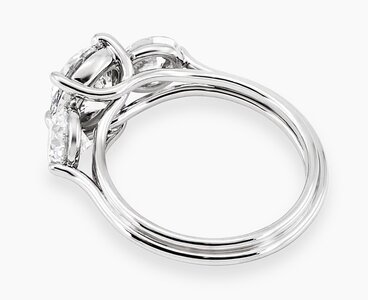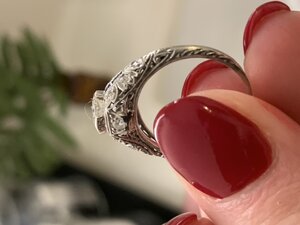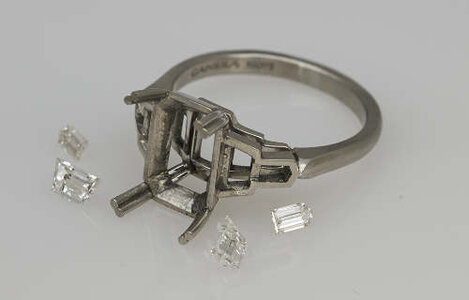NicoleNeedsHelp
Brilliant_Rock
- Joined
- Aug 20, 2020
- Messages
- 507

It's really not a simple question because there are so many variables....
The type of ring, for one.
What might look the prettiest might not necessarily be the most practical....but again, specifics matter
Wow— is this the Victor Canera? I’m so honored you replied.@NicoleNeedsHelp
Since this is a topic I know about, I thought I’d chime in. If a design can be hand fabricated in a cost effective manner, it’s going to be higher quality than a cast ring. Whether the difference is 50% better of 5% better will depend on how well the cast ring is executed but there will always be a gap built in between the two processes.
Some ring designs lend themselves to casting though. These are usually the really unique designs that have swirly or swooping elements. Designs like that would be hard to execute by hand fabricating them. You can only manipulate metal so much before the laws of physics kick inOr, if these types of designs can be hand fabricated, it would be cost prohibitive because of the amount of time someone would need to put into them in order to create the ring. Some types of rings like simple men’s wedding bands are nicer but I wouldn’t say they’re earth shatteringly more nice if they’re hand fabricated or machined. Interestingly though, most mid to high end wedding band makers still don’t cast their bands so that might tell you something.
Ring designs like solitaires, trilogies and five stone rings really lend themselves to hand fabrication. There are even specific parts of rings like this which are objectively nicer when hand fabricating the ring. For example, prong work and the gallery.
Prongs will be more delicate and refined when hand fabricating them than casting. You can have perfect prongs by pulling metal wire from a draw plate and then soldering them on the ring. A draw plate is a piece of metal with progressively smaller holes in it used to drawn wire. The prongs are perfectly, cylindrically shaped, not overly chunky and clunky. The casting way of doing it is having the computer create the wax, cast the wax, have someone clean the cast prong. There’s also the advantage of additional metal density with hand forged metal which makes the prongs a bit stronger than cast metal. That’s what happens to metal when you press it and form it using a lot of pressure. It actually tightens the metal molecules together.
Other parts of a ring like the gallery are objectively more clean and refined when hand fabricating the ring. That’s part and parcel with being able to assemble separate elements of the ring like the basket, prongs, shank etc. Some shank designs lend themselves especially well to this. Like for example “tri-wire” shanks. The reason we call these tri-wire is because they’re literally made from three separate wires that are drawn from a draw plate. The advantage is going to be that that tri-wire shank is going to be perfectly shaped with individually drawn wires which were connected together. I’m attaching a photo of one below which combines a tri-wire shank in a trilogy design.
Having said that, yes, usually hand fabricated jewelry involves more labor by a more specialized craftsman who's paid a higher salary than unskilled labor and so the finished jewel will be inherently more expensive than a cast ring. The difference in cost will grow as the complexity of the ring adds to the amount of time required to complete it. That’s just the way it goes.
So I would just recommend clients think about the type of ring design that they had in mind. set priorities as to what’s important to them and then make a decision. If you're lucky enough have someone local that offers hand fabricated jewelry, go take a look and see for yourself.
Good luck!
@nojs
The earrings you’re showing are one design where the difference wouldn’t be glaring between the two types of manufacturing styles. They’re a more timeless/ straightforward type of design with millgrain on the edges.They’re beautiful earrings btw.
/—-/ All the best,


@nojs
So just to clarify, the difference between hand fabricating something vs. casting doesn’t necessarily come down to a difference in the texture of the metal. Cast metal is rough but can be cleaned to a nice finish.
If you had a design for example that was a simple block that was 4mm square and cast it into metal, and set diamonds on it, the difference wouldn’t really be visible than if you had hand fabricated it. This also applies to rings that have plain shanks or “raised shanks” for example. The metal can be finished nicely after casting. IF that shank is a cathedral, then the difference starts becoming more obvious with hand fabricating it. The cathedral would objectively be nicer in a hand fabricated ring. The open gallery areas, like the head and other parts would also be objectively more nice with a hand fabricated ring. This is the reason why solitaire designs like these, trilogies, five stone rings are nicer IMHO when hand fabricated. I’m attaching a photo of a ring straight from the bench to give an example. There’s no physical way the gallery of this design can be as nicely done with casting. I'm showing the inside of the ring before it's even been polished prior to setting the diamonds... There’s no physical way the prongs could be done as nicely with casting. It’s a limitation of the technique that becomes apparent with ring designs like these. Now whether a client can appreciate this or would appreciate this is a different question.
Good luck
Ok, I don't know if this can attributed to hand forged v cast, but my VC hand forged setting has very few visible scratches. Have had it for four years now. There is patina to be sure, but deeper scratches that are visible to my naked eye, very few.
The cast platinum solitaire setting has shown more visible scratches in just a few weeks. I wear both rings next to other rings.
So this is just an observation. Not sure if hand forged v cast is the reason.